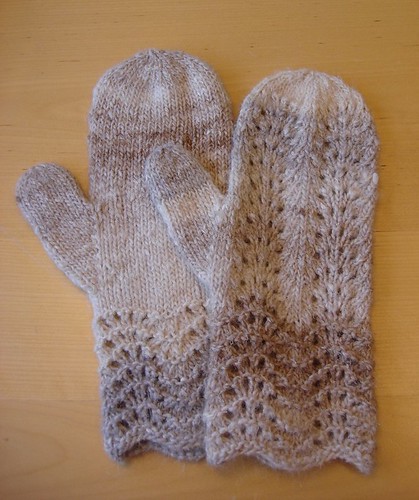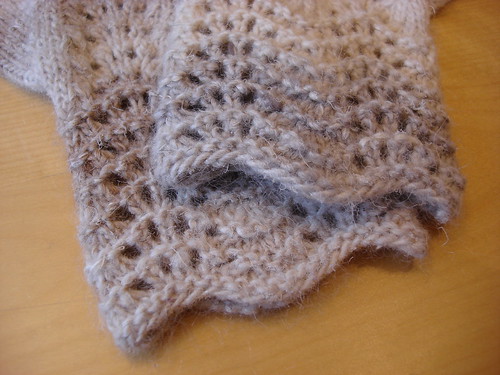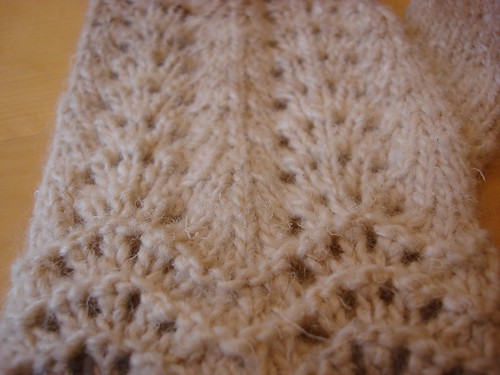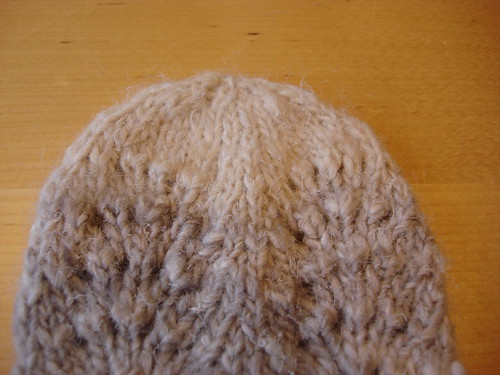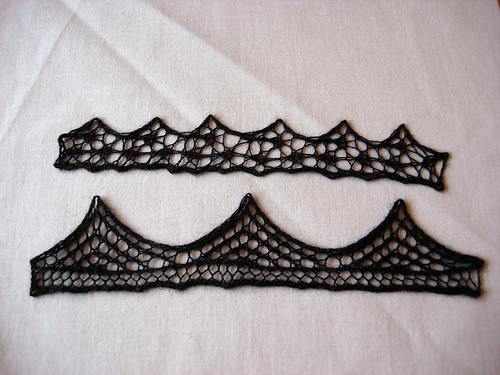
The treble diamond edging (top) is totally charming, now that I can see that there really are three tiny diamonds in there. It's a bit strange to knit; I was starting to get the hang of it here, but I think it would take a few more repeats before I wouldn't have to look at the chart all the time anymore.

I only made one small change, which was to add a yo-k2tog at the beginning of every even-numbered row on the scallop edging (bottom). It was the only one out of the three that didn't have that lacy edge written into the pattern. I did this for two reasons: first because the poor edging looked a little bare without it beside the other swatch, and second because I find this makes a stretchier edge that's easier to block into big swoopy scallops than a plain garter edge. I'm sort of enamoured of this edging, actually! I like the contrast between the faggoting along the straight edge and the eyelets in the scallop. The yarnovers in the straight edge make little diamond or house shapes and the others are quite round, and I like seeing that difference close together in the same piece.
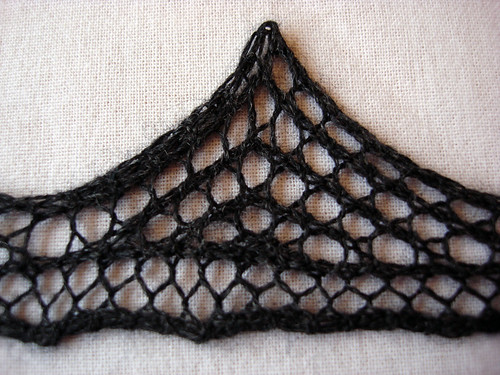
Speaking of lacy edges! I tend not to pin out each yarnover loop, even though I think it might be The Done Thing. This is partly because I just don't own that many T-pins. (I have about 600, but there are more loops than that in most shawls I knit.) It is also partly because I am worried about breaking the yarn when I'm stretching a shawl out during blocking; I would rather pin through yarnovers a little way away from the edge of the knitting (or thread wires through there), because I tend to stretch the living daylights out of my knitting when I block it. It's also partly because I conceive of the lacy edge as a way of adding some give to the fabric and not as a decorative element; in my head it's more like lengthening the edge than it is like a tiny extra pattern. Really it just doesn't occur to me while I'm blocking a piece that I could pin out each loop.
Back to edgings: the scallopy one does have one unevenness that bothers me, and that's the extra stitch near the scalloped edge on the decreasing slope. (Look at the chart; rows 2-14 have two stitches between the yarnover closest to the left edge and the edge itself, and rows 16-26 have three.) That means that the decreasing slope is slightly thicker than the increasing slope, so the edging looks vaguely off-kilter. If I used this pattern to edge a project, that's something I would change, probably by shoving all the patterning beyond the faggoted edge beginning with row 16 over one stitch to the left (as charted).
The point lace edging—which I didn't knit, because I am sort of planning a project around it, so I'll get to it soon—is familiar to me; Sharon Miller calls the allover pattern it's based on "bird's eye", and it's mostly just a collection of abutted spider motifs. (It's not difficult once you get the hang of it, but it still looks ugly and off-putting in chart form.) The interesting thing about it is that since each spider takes a few rows to execute, the edging has a gentle curve to it instead of the usual pointiness. You could make a similar edging for a piece with bead motifs in it by substituting beads for some or all of the spiders.
The project I'm thinking about is a little bird's eye scarf with that curviness on each long edge, and maybe tiny picots on the cast-on and cast-off edges. I like scarves that you can make out of one 400m/50g skein of laceweight whatever, and I like pretty dainty edges on things, but I feel like narrow scarves are overwhelmed by having edgings affixed to them. This one would grow quite organically out of the allover pattern, and I think the effect would be lovely.
One last item! I have to respectfully disagree with Franklin on the subject of when to weave in ends. If you do it before blocking, any unevenness in your weaving-in will come out in the wash. I am all about solutions that result in neatness without my having to be neat.
